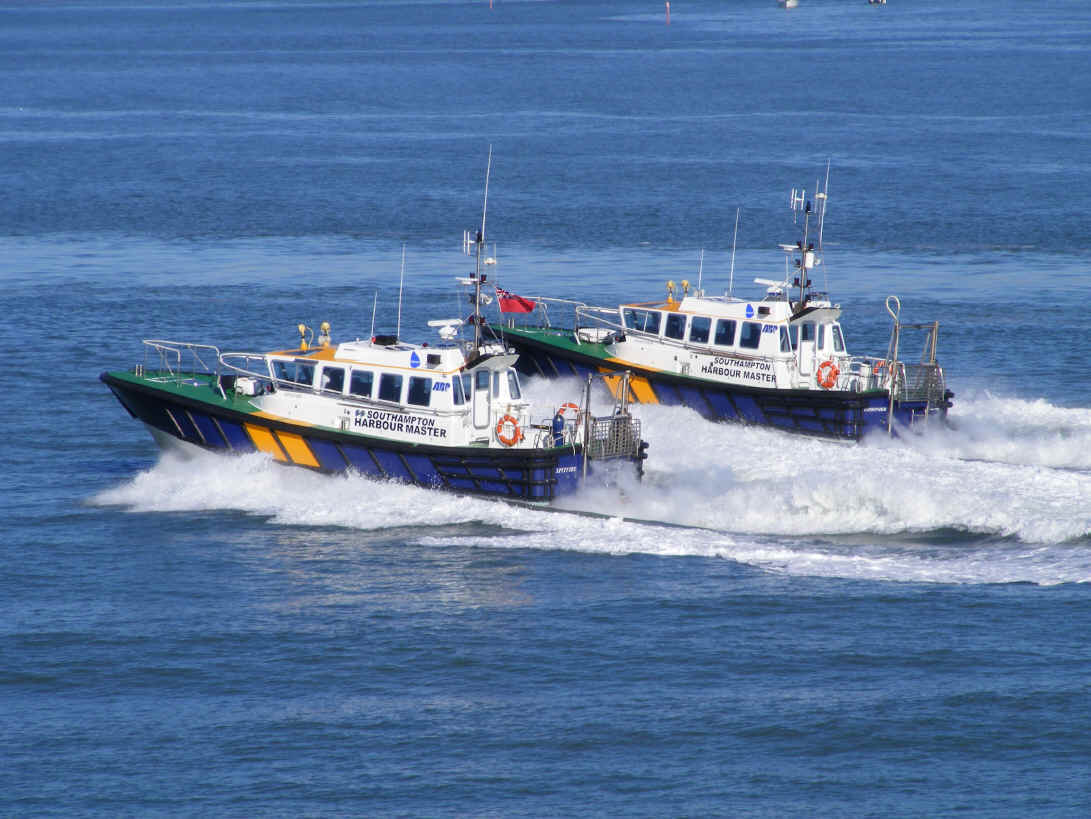
NEWSLETTER JUNE 2010
PATHFINDER & SPITFIRE WORKING TOGETHER
Ken Warren, the Assistant Harbormaster at the port of Southampton sent me this nice photo taken of Spitfire and Pathfinder running alongside each other on patrol in Southampton's waters.

Spitfire and Pathfinder at their naming ceremony in Southampton.
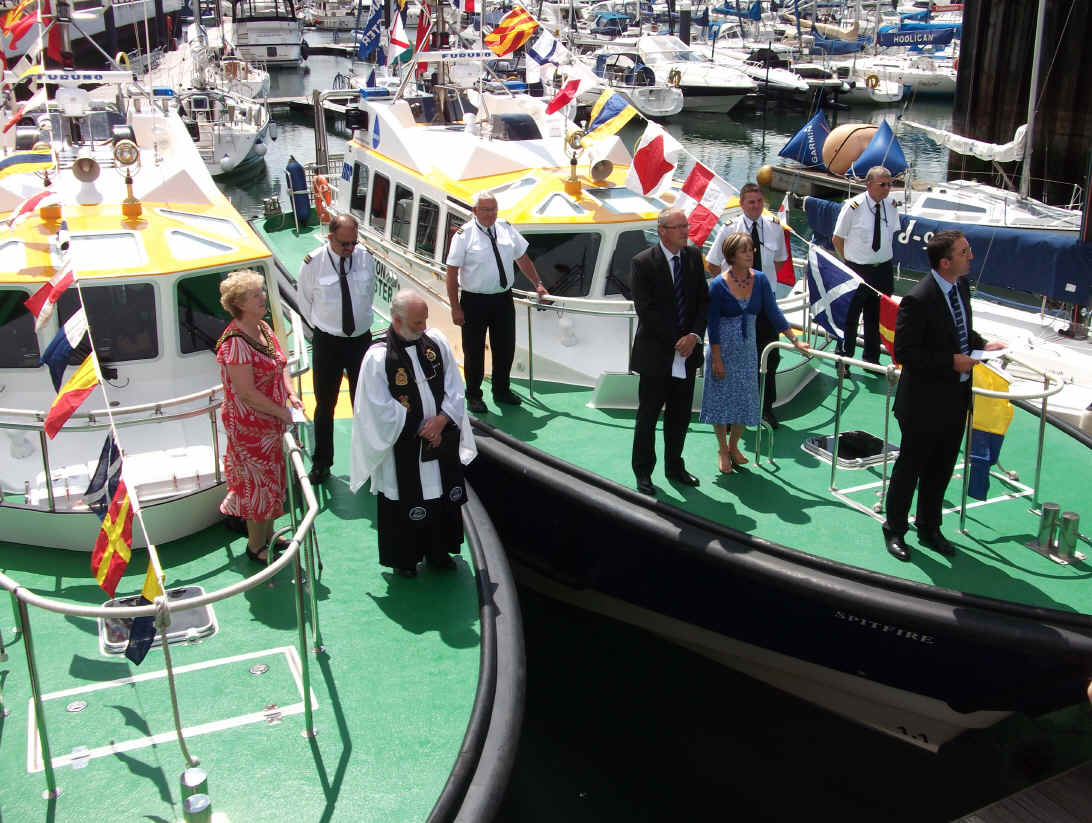
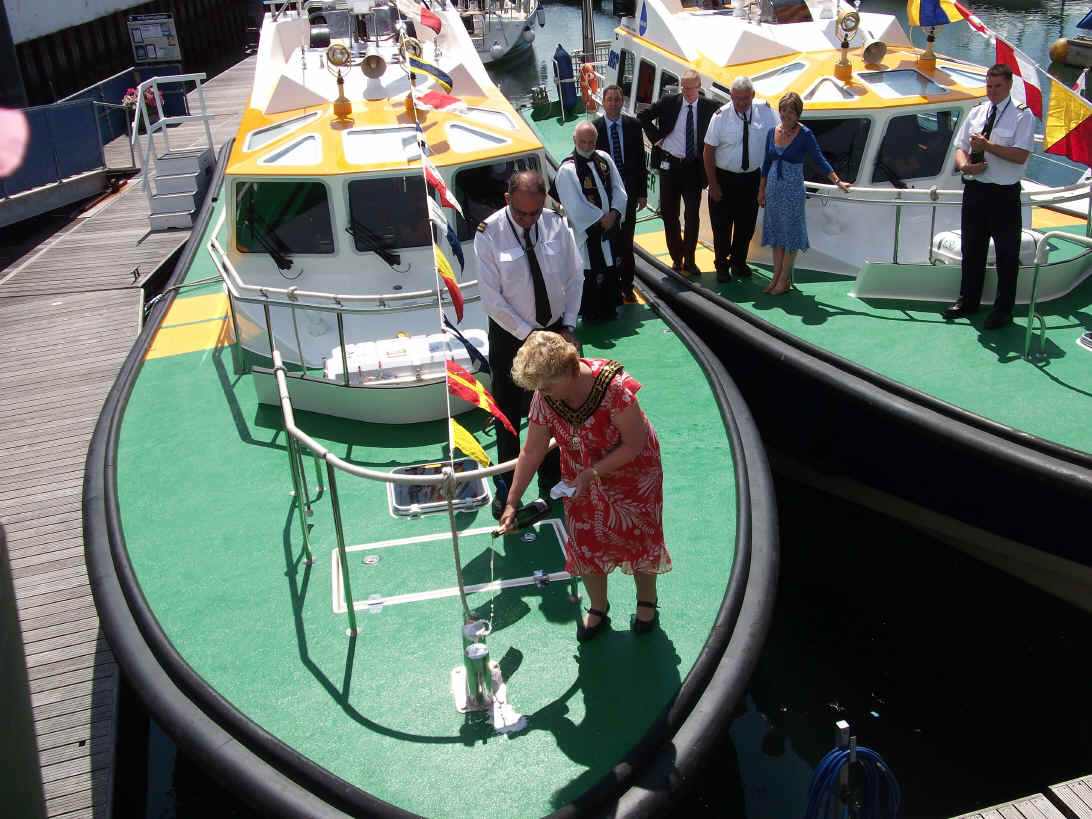
BAYONNE PILOTS HOLD NAMING CEREMONY FOR IZURDIA
In service for nearly 12mths, the pilots at Bayonne held the naming ceremony for Izurdia, below she is receiving the blessing.
We received this nice letter of recommendation from Bertrand Moutard of the Bayonne Pilots.
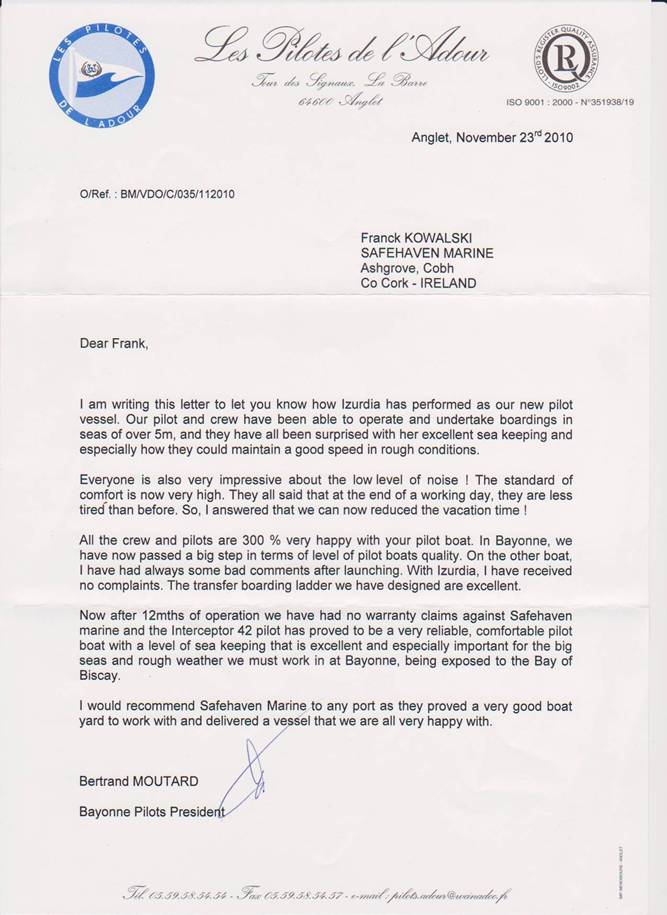
PORT OF BORDEAUX'S NEW INTERCEPTOR 48 PILOT BOAT
'QUINOA' IS DELIVERED!
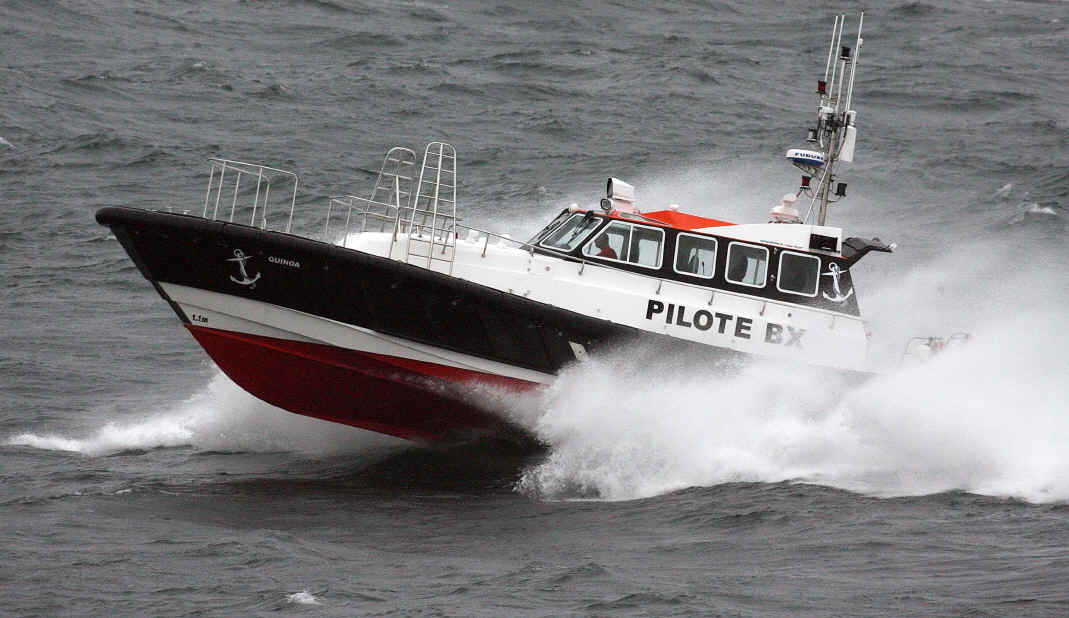
Quinoa, our first Interceptor 48 / 14.5m pilot vessel has been delivered by sea to Bordeaux, here is an account of the voyage by Olivier Barreau, the pilot chiefly involved in overseeing her construction and who undertook the delivery voyage.
THE VOYAGE OF
'QUINOA' FROM
Quinoa left Ireland at 11am on Saturday, conditions
were NW force 5 with a 2m swell offshore, conditions being worst off Ireland
where there was a cross sea of the main Westerly swell, and wind waves at 90
degrees to this, but she handled conditions perfectly and was able to average
22kts comfortably in a following sea. We made the140nm run to Lands End in 6
hrs. After refueling at Newlyn and a short break, we cast off at
We continued down through Biscay stopping off at
Concarneau in the morning where we refueled and drank a toast of
We departed quite late and headed to
We continued on towards
The pilots at Bordeaux have to deal with very challenging and at times dangerous seas at the entrance to the Harbour where big Atlantic swells from the Bay of Biscay meet the strong 3-4kt ebb tide from the Gironde River and rage with special violence causing breaking seas at the Bar that reach over 10m in height during winter months, the Pilot vessel is expected to be able to navigate the Bar safely in up to 5m wave heights. As a consequence a fundamental requirement by the Port was for a pilot vessel with very high levels of sea keeping and Safehaven Marines reputation in this respect was unsurpassed by any other builder. An important part of the design brief was for the Interceptor 48 to be fully self righting in the event of capsize by virtue of her high buoyancy superstructure and consequently the vessel has been built with numerous features such as automatically closing air vents, 15mm thick windows and watertight cockpit doors. In addition the superstructures forward windows are aft sloping to minimise pressure loadings when taking green seas over the bow, (a fairly regular occurrence due to the extreme conditions she operates in) Another advantage of the Interceptor 48 is the inclusion of a large and spacious forward cabin, this is achieved by virtue of having her engines installed further aft under the main cabin, where they are subject to less loadings and accelerations in rough seas, and are quickly removed in the unlikely event of failure through hatches incorporated in the main cabin sole and cabin roof. The forward cabin on Quinoa features bunk berths allowing the pilots to rest and relax comfortably during transits at night time, and provides increased seating capacity that can be utilised in an emergency, or when additional passenger seating is required.. Quinoa is fitted with Safehaven's unique pilot boarding ladder design improving safety for pilots when boarding but causing minimum obstruction to visibility. Quinoa was built under Bureau Veritas survey to the strict French Maritime authority requirements.
The vessel was delivered at the end of September by
Olivier Barreau, the pilot specifically involved in overseeing her design and
construction whom became good friends with Safehaven's owner and designer Frank
Kowalski during the 12mths of her construction. The 500nm voyage from
For full information click here
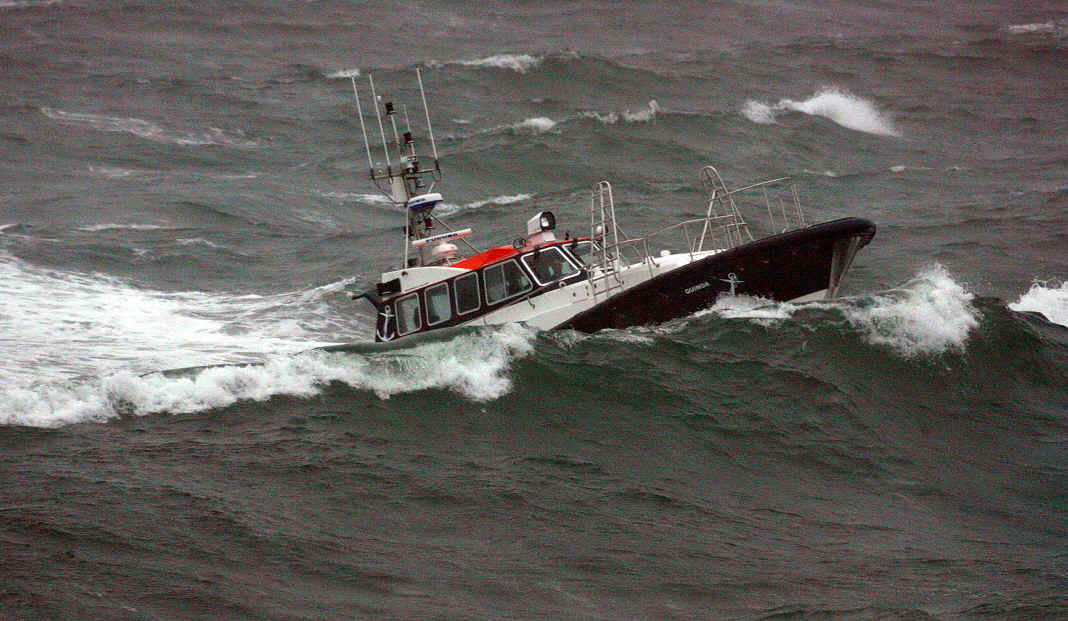
Above, some photos of Quinoa undergoing rough weather seekeeping trials during which she provd excellent with a soft ride running into head seas and being very stable running down wind with a following sea (above) you can see a video of the trials from this link- SEE THE VIDEO
The Interceptor 48 has proved to be a very fast and efficient hull design. Fitted with Iveco C13 engines at a continuous rating of 520hp Quinoa achieved a maximum speed with 1/4 fuel load of 26kts, and 25kts fully loaded with 1850 litres fuel and three crew at a displacement of 19,200kg.
The 'Syndicat Professional des pilotes de la Gironde will be taking delivery of 'Quinoa' our Interceptor 48 'OCEAN 3'. This vessel is built to an exceptional standard with a very high specification, very similar to the Port of St Malo's and Bayonne's pilot vessels supplied before. She is powered by a pair of Iveco 13litre engines at 520hp. She incorporates the French industry standard OCEAN 3 fendering, which features a 300mm lightweight rubberized skin foam fender, retained in a recess in the hull and secured by multiple straps. She is fitted with our pilot boarding ladders that facilitating safe pilot transfer and a Jason cradle MOB recovery system stored in a recess in the superstructure side. Below 'Quino' has turned out a very fine looking vessel, with very graceful lines, her long sleek design is enhanced with rearward sloping windows giving her a modern, handsome look and will lessen the impact of big breaking seas that she will be facing crossing the bar at the entrance to Bordeaux, where big swells from the Bay of Biscay reach 10m during the winter months and she will have to operate in up to 5m seas.
Possibly the prettiest Pilot vessel we have built, the Interceptor 48 has sleek and graceful lines
Her interior is finished to a very high standard, fully lined throughout in vinyl with black gloss laminates, teak and holy cabin sole sandwiched with 40mm of soundproofing and wood trimming produce an exceptionally luxurious environment for her pilots and crew. Four reclining Recardo air suspension pilot seats with side bolsters will give a comfortable ride in rough weather.
The helm position has been especially designed to provide the ultimate comfort and control for the helmsman, the design wraps around with all instrumentation clearly visible and all the vessel controls have been ergonomically designed for comfort and visibility. 'Quinoa' is fitted with a sophisticated navigation package centered around the Furuno Nav Net 3D electronic system
Twin Iveco C13 520hp engines and Twin Disc 5114 Quick Shift gearboxes. Engineering and electrical installations are the the highest international standards.
Above, Photos of Island Tiger working on windfarms off UK East Coats July 2010
Three Interceptors at St Kilda to the West of the Island of Harris, 100nm into the North Atlantic from the Scottish Mainland.
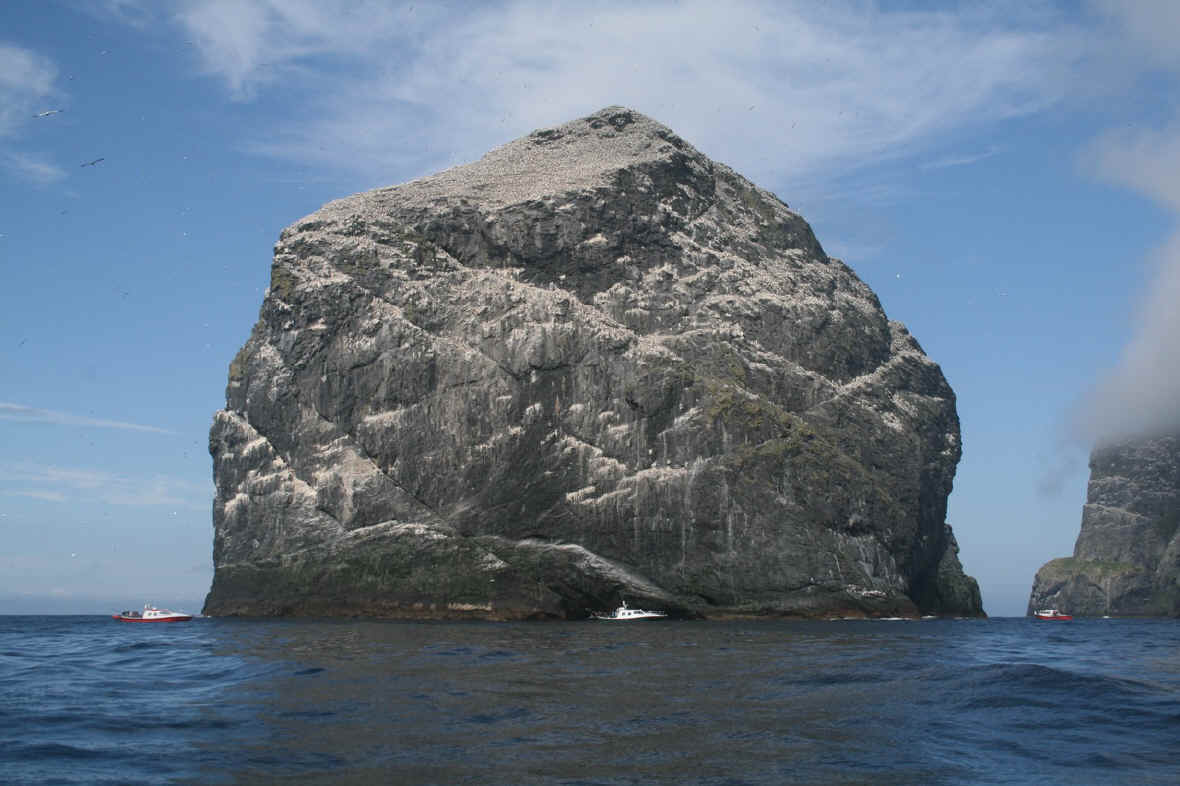
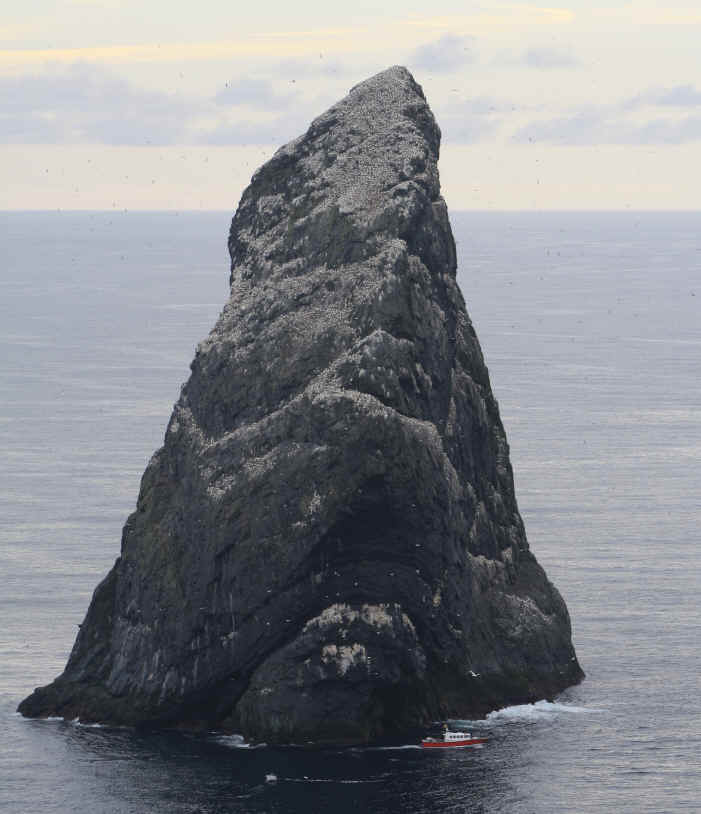
Safehaven Marine at Seawork 2010.
We were strongly represented at this years Seawork show in Southampton. Island Tiger our Wildcat 53 windfarm support vessel traveled from Dublin after her naming ceremony down the Irish Sea and along the English Channel to Southampton where she was displayed alongside both Interceptor 55's SPITFIRE and PATHFINDER supplied previously 12mths and 6mths ago to the Port of Southampton. We had a big presence with three large vessels and the only pilot vessels on display at the show. Island Tiger was very well received at the show everyone commenting on what a fine looking and well finished vessel she was. It was nice to see both of Southampton's sister ships moored along side.



'ESPINHEIRO' Interceptor 42 pilot launched for the port of Aveiro, Portugal.
Espinheiro has now been launched. The second of two pilot boats being built for the Portuguese ports of Figueira and Averio. Both vessels were ordered after an International tender in 2008. Certainly our Interceptor 55 Atlantida Azul supplied to the Portuguese port of Sines in 2008, and in operation very successfully since no doubt played a part in Safehaven being chosen to supply the two pilot vessels. Both Ports are open to the Bay of Biscay and as such subject to the large swell heights prevalent in the Bay of Biscay during winter months, The Ports needed a vessel with fine seakeeping to deal with the treacherous conditions that exist at the harbour entrance in poor weather, the vessels routinely having to operate in 6-7m swells which can break heavily over the Bar.
Espinheiro is powered by the smaller
engine option of Volvo D9 engines rated at 425hp, providing a 23kts maximum
speed and an 18-19kts operational speed.
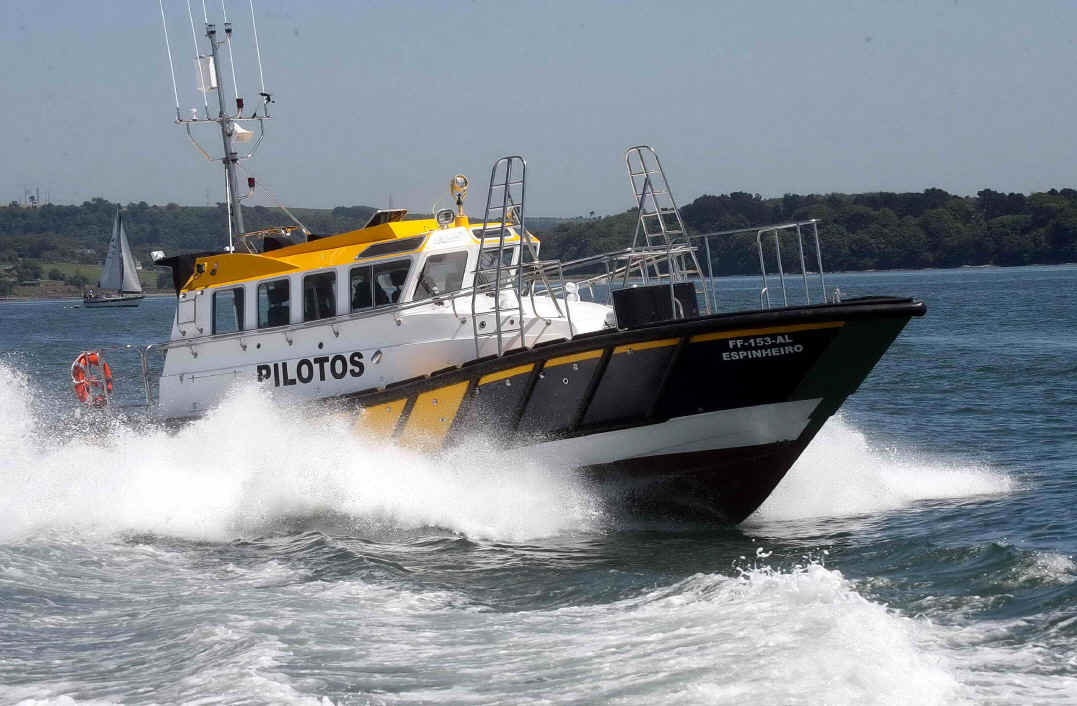
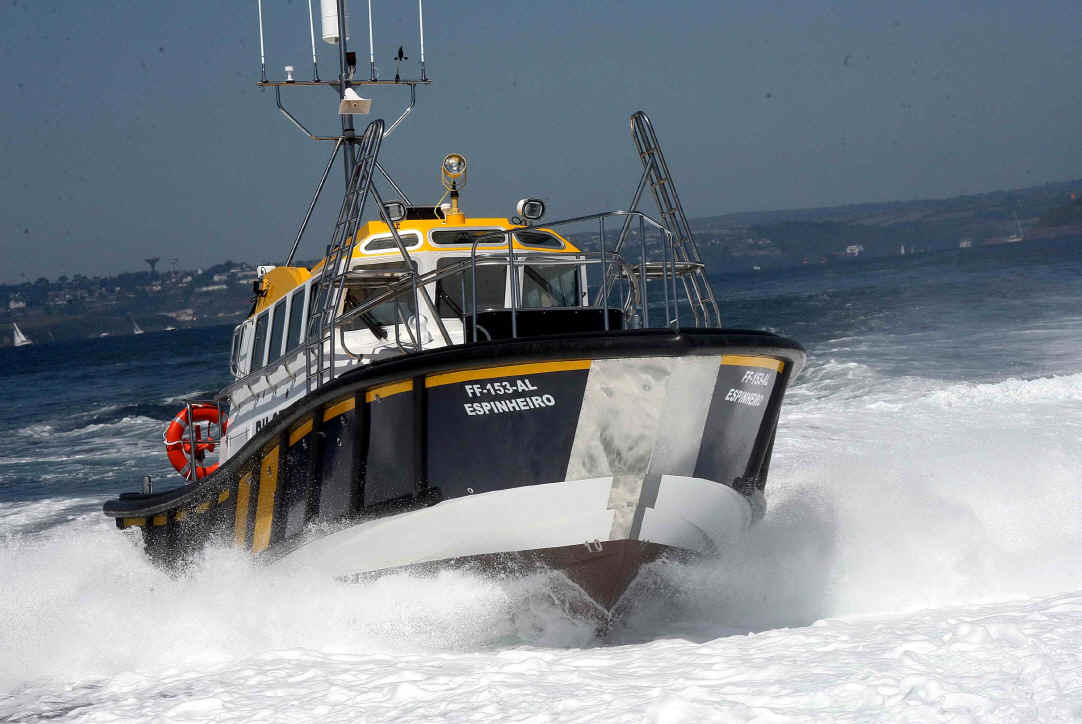
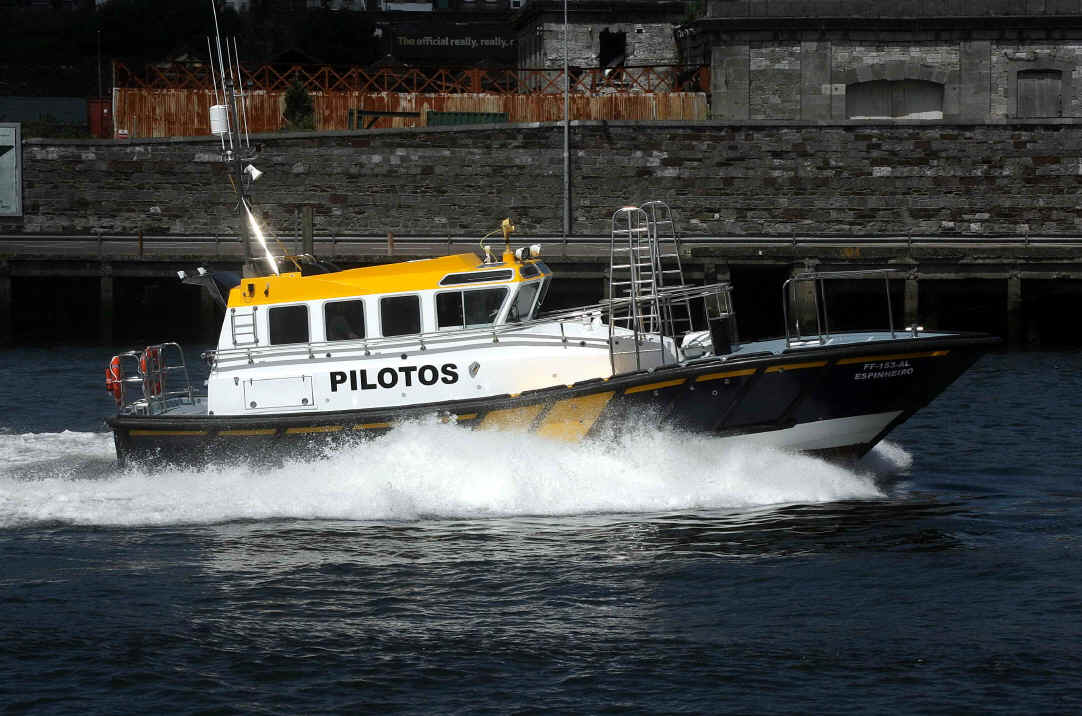
‘Espinheiro’ will be
fitted with Safehaven's proven sacrificial fender system combined with multiple
diagonals and lower fender runs fully protecting the vessels hull and deck, the
sacrificial fender system utilizes a large 280mm diameter rubber outer fender
which fits, like a glove over the crafts 150mm main deck fender at the pilot
boats shoulders, and is secured in place with a strap and ratchet system, the
fender is very cheap to replace and is proving to have an 18mth to 2 yr lifespan
in hard pilot usage, it significantly reduces impact loadings and provided a
high level of protection to the pilot boats main fendering and structure.
‘Espinheiro’ is fitted with a Jasons Cradle MOB recovery system which is
stored in a recessed locker in the superstructure side, allowing for quick
deployment, its positioning is such that then the vessel is positioned up wind
of the casualty the vessel will adopt the natural beam on drift attitude that
most craft adopt and thereby be allowed to drift down whereby the casualty can
be recovered safely with out need for excessive maneuvering risking injury from
propellers as is the case with stern mounted recovery platforms.
Fitted with the smaller engine option of Volvo D9's rated at 425hp on rating 2 for 2000hrs per year, with a 2000 continuous rpm giving a 18-19kts operational speed and a maximum speed of 23kts for 1 in 6hrs, and prove an economical choice for ports with short transit times where a lower speed is acceptable.
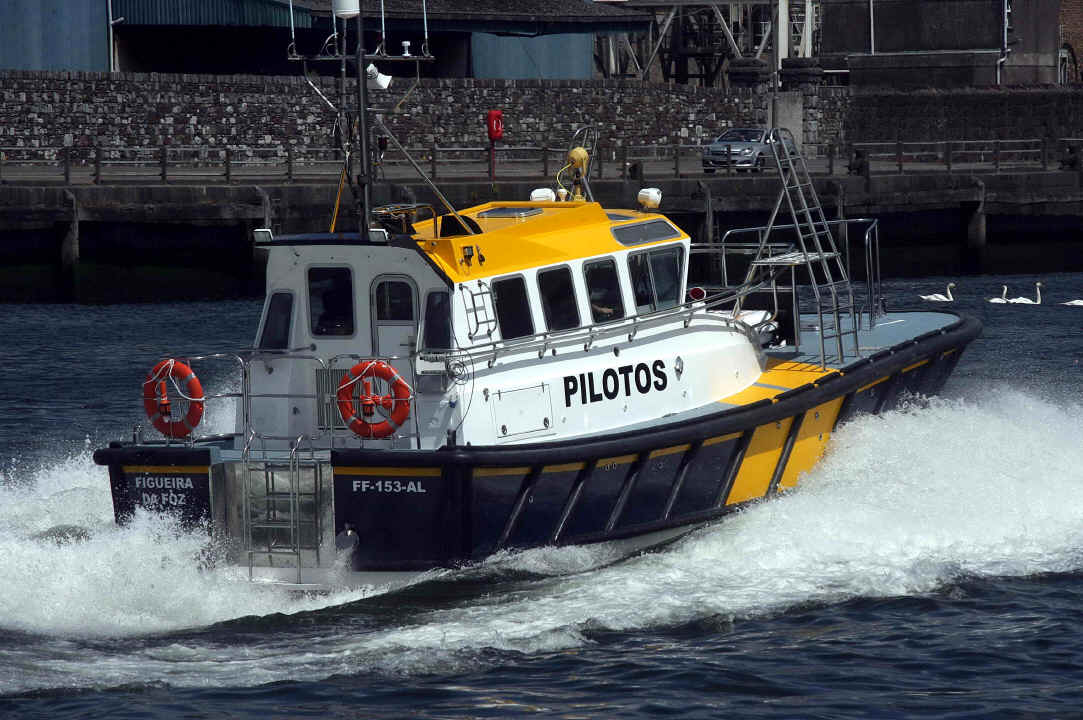
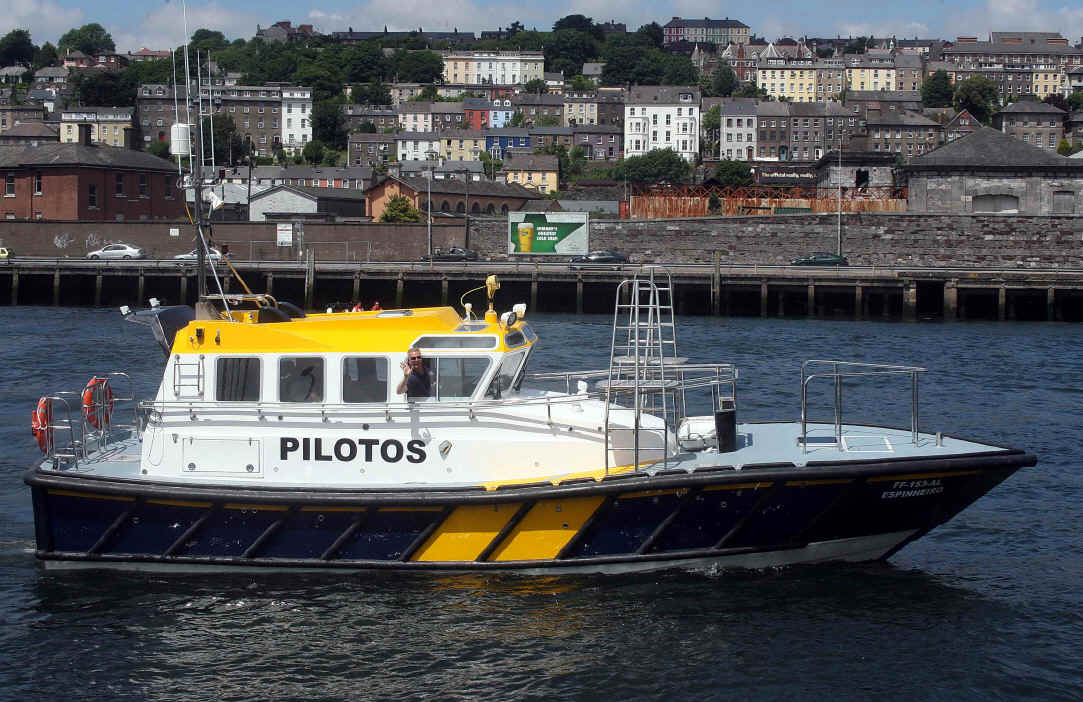


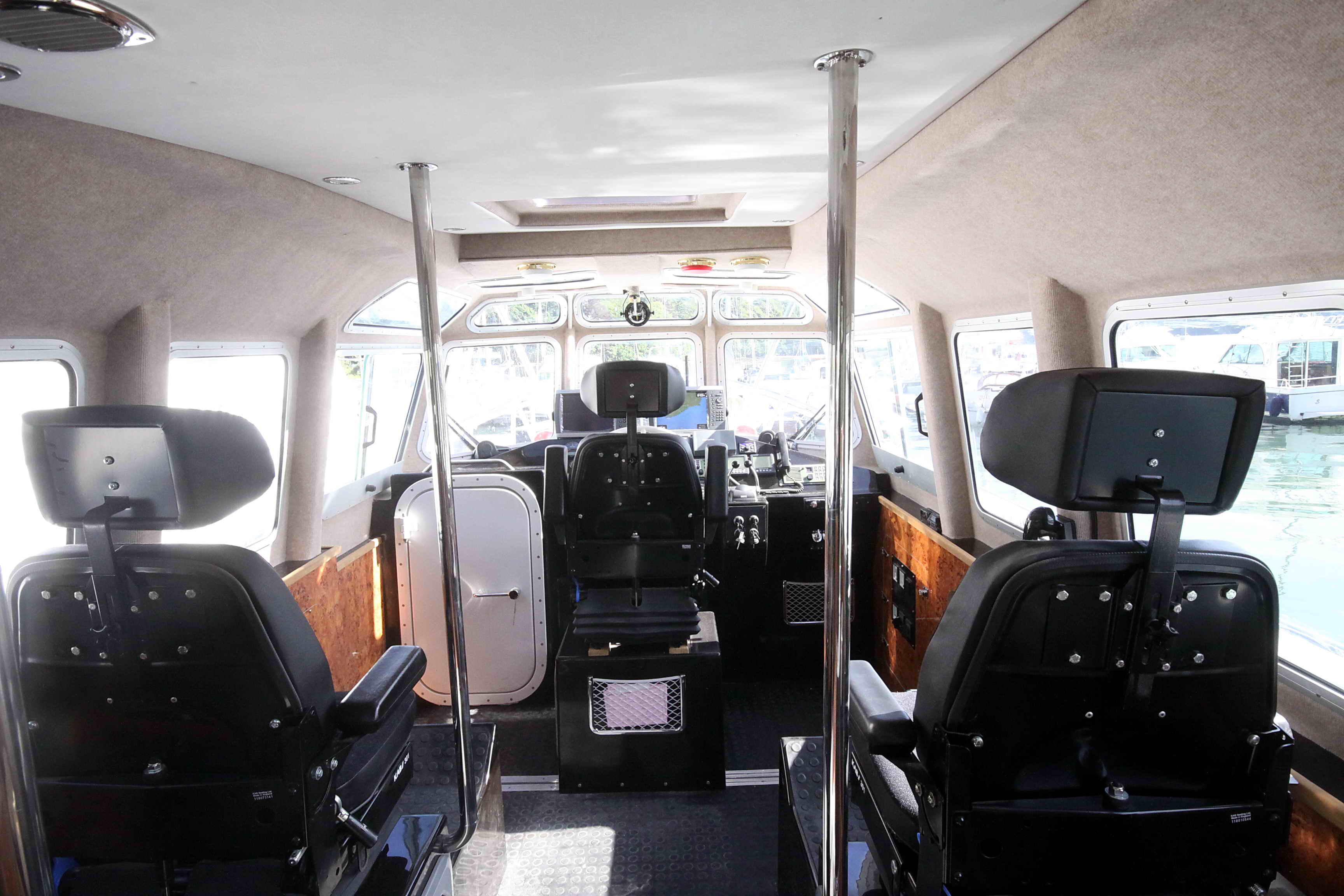
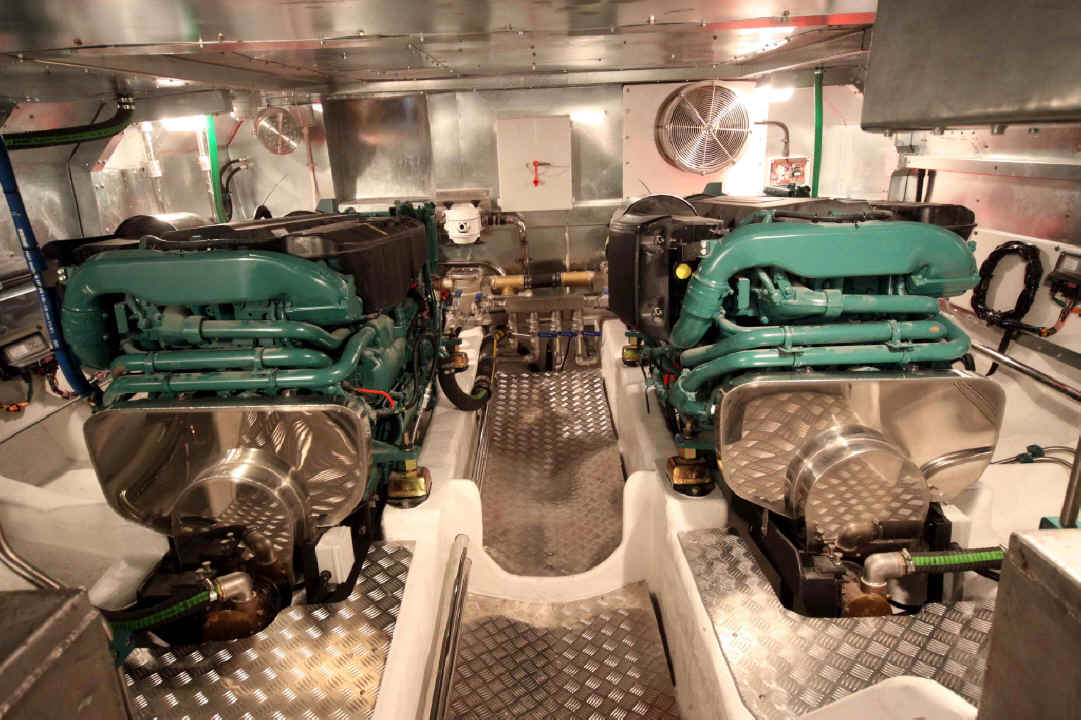
'ISLAND TIGER' A WILDCAT 53 / 16m 'WIND FARM SERVICE VESSEL'
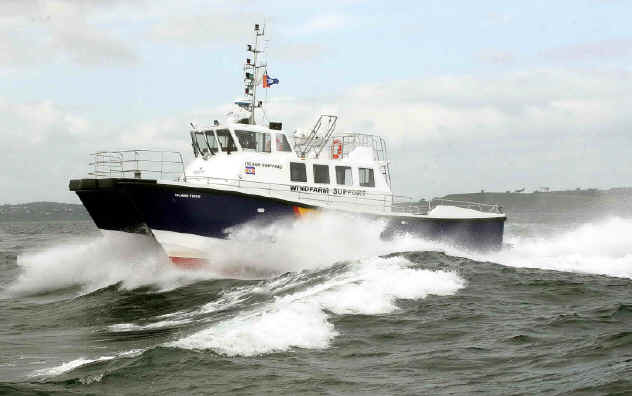
Safehaven
Marine have launched 'ISLAND TIGER' the first of our new GRP Windfarm Catamarans,
the Wildcat 53 / 16m. This is a completely new design based on our highly
respected Wildcat 36/40 design, incorporating the same high buoyancy bow, twin
chine catamaran hull form that has proved so successful in providing exceptional
levels of sea keeping and performance from Safehaven’s Wildcats over the past
5 years. 'ISLAND TIGER' is 16m long
(17m inc dive platforms) with a 6m / 20ft
beam and will provide a very stable platform that will suit a multitude
of roles from passenger, crew transfer and commercial workboat, but she is
specifically designed as a wind farm support vessel. To this end the bow area
has been designed to accommodate a specially developed fender system from Ocean
3. The fender design is of high density foam core 300m x 400mm with a heavy 50mm
thick rubber wall to cushion impacts
and stresses when the bow is held against windfarm platforms in heavy weather.
No stranger to building exceptionally strong GRP hulls, the Wildcat 50 will have
the same heavy duty scantlings as tour renowned pilot boats, to provide a
vessel that can withstand tough use in the harsh windfarm support vessel
environment.
'ISLAND
TIGER' is powered by twin Scania D12 650hp engines driving Ultra Dynamics
waterjets and on sea trials achieved a 25kts maximum speed which gives an
operational speed of 23kts at 80% of max power on a 25,000kg lightship
displacment. Larger engines such as the Scania or Volvo D16
engines can alternately be fitted for higher speeds.
The
superstructure is a raised bridge deck design with the helm and navigators
position elevated to provide excellent visibility. The cabin is centrally
positioned in an ‘island configuration’ with a clear 750mm walkway each side
with and around the bow where there
is a cargo lifting space. This provides a safe passageway and spacious work and
boarding area at the bow.
Aft
twin dive platforms at the transom of each hull give waterline access through
transom gates, and the well decked aft cockpit features a HIAB crane and a large
clear cargo area.
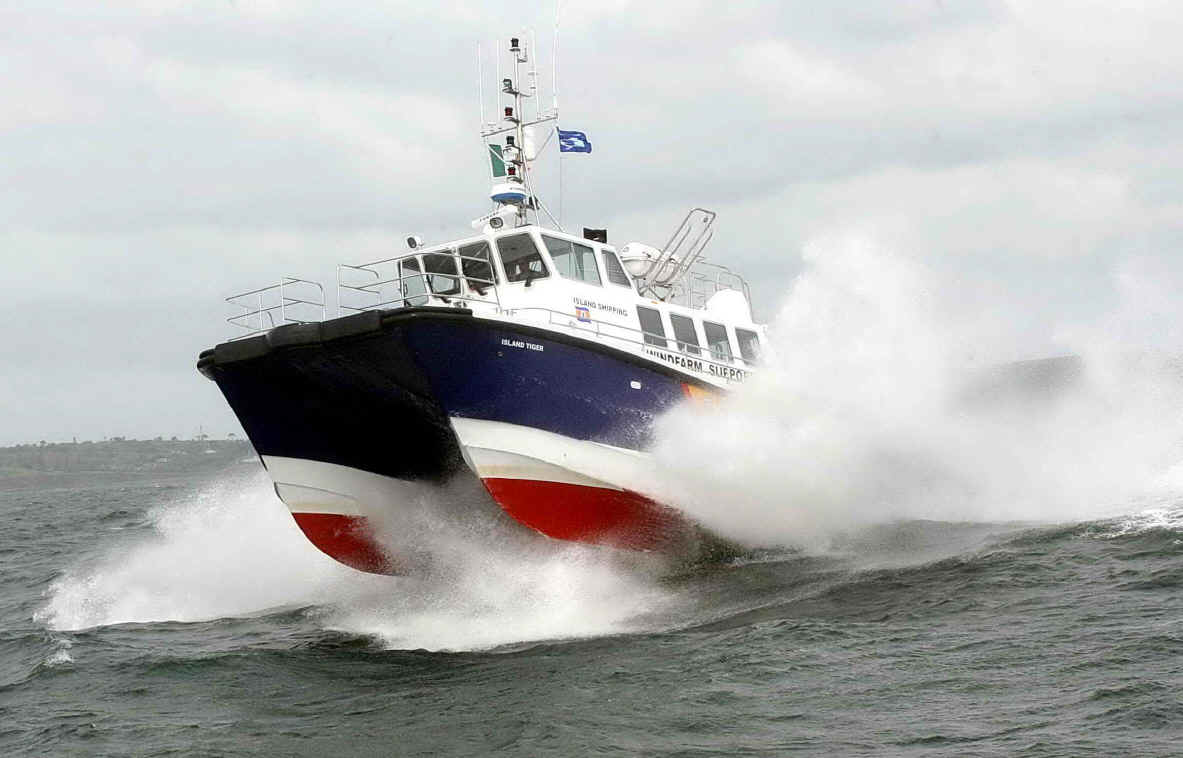
Above and below, photos taken from her rough weather sea trials, you can see a video of the trials from this link- SEE THE VIDEO
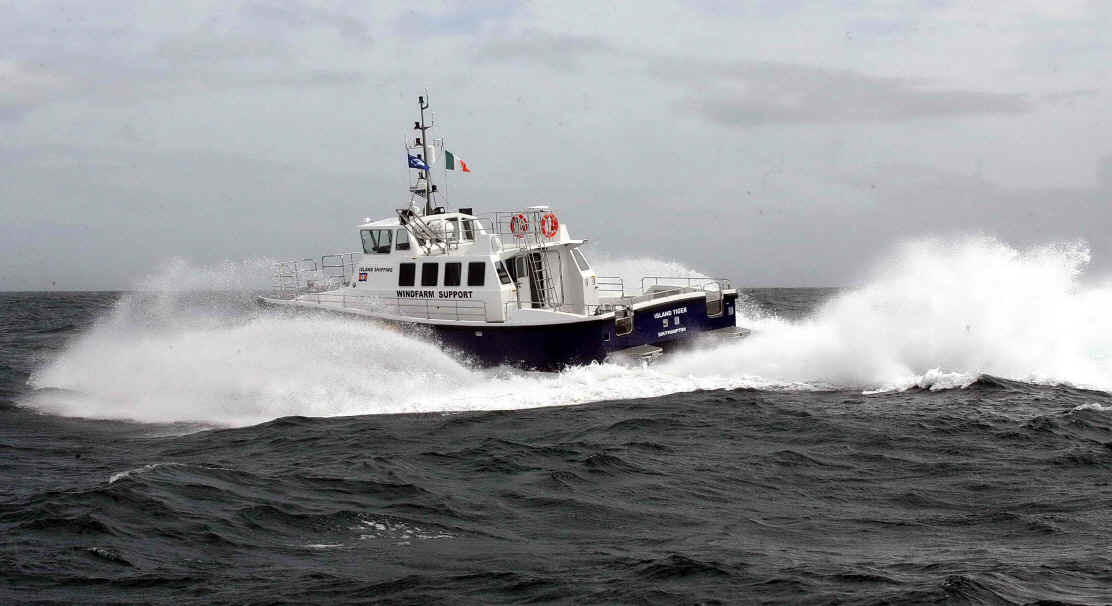
Below, undertaking trials with the Irish coastguard helicopter and took some nice pics, we also had a video made, - SEE THE VIDEO
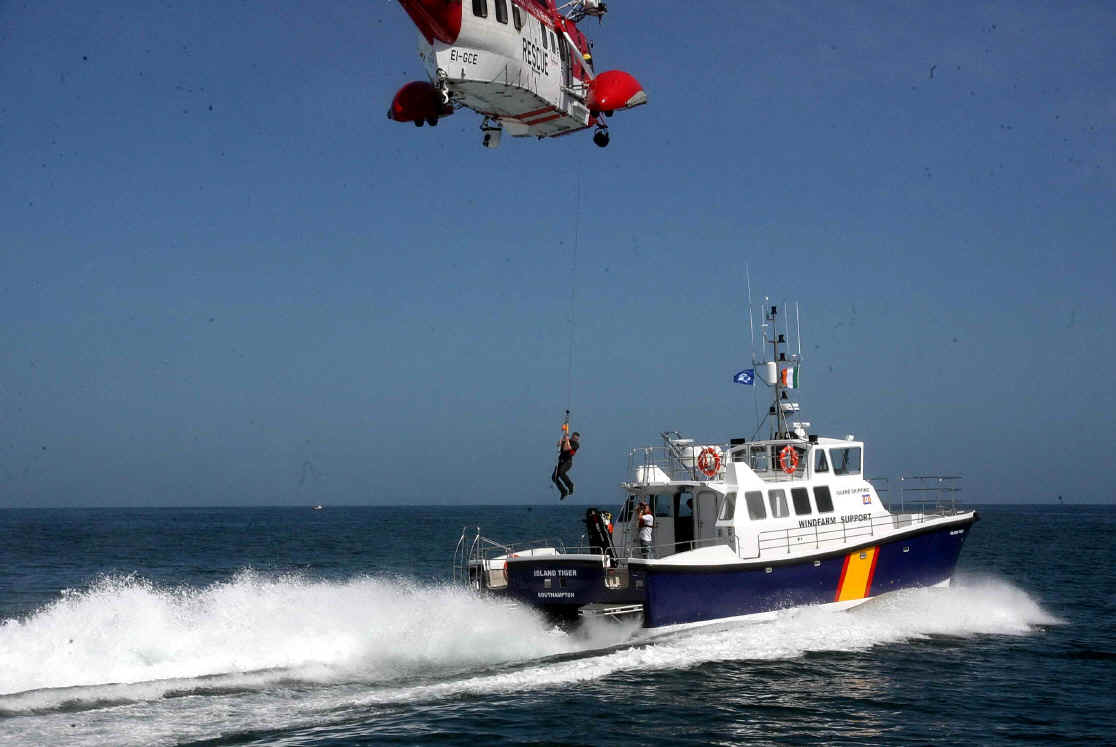
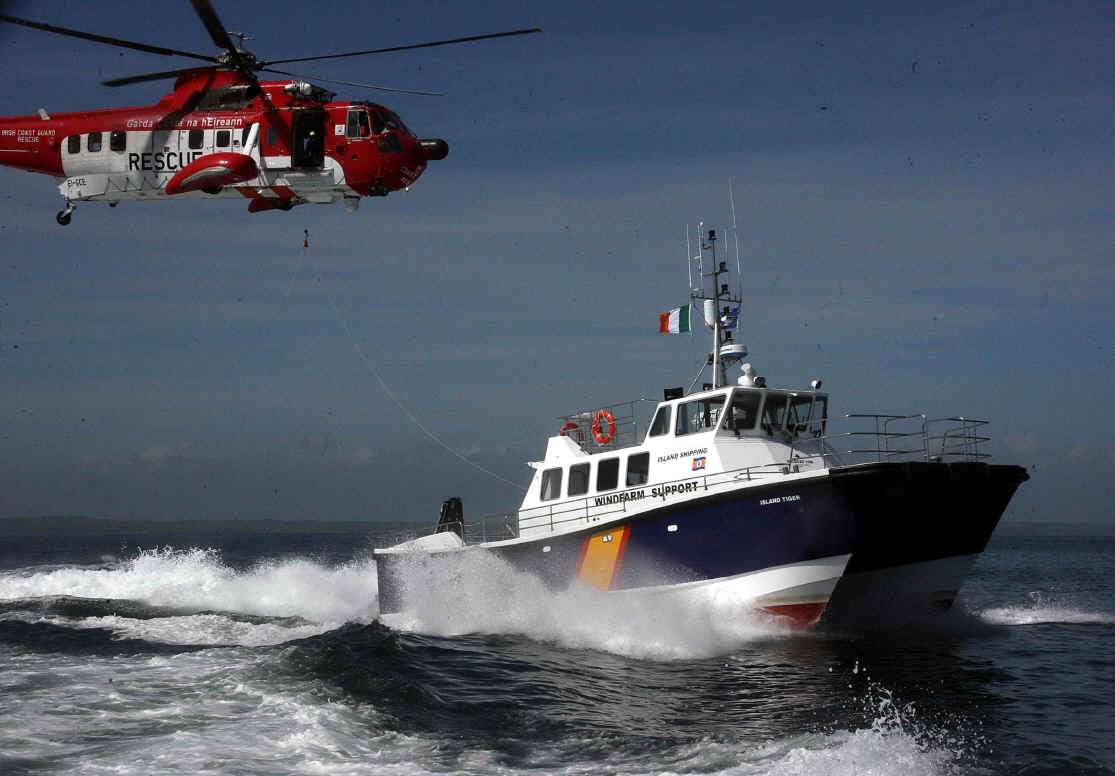
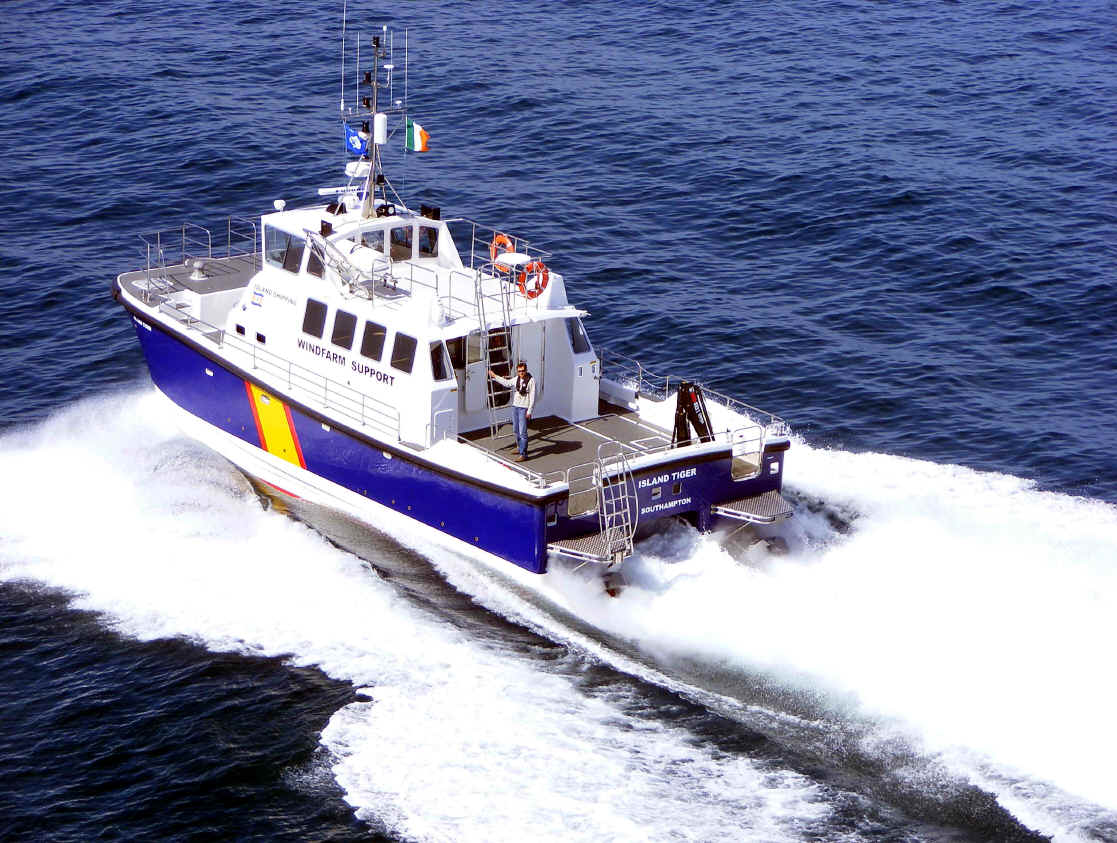
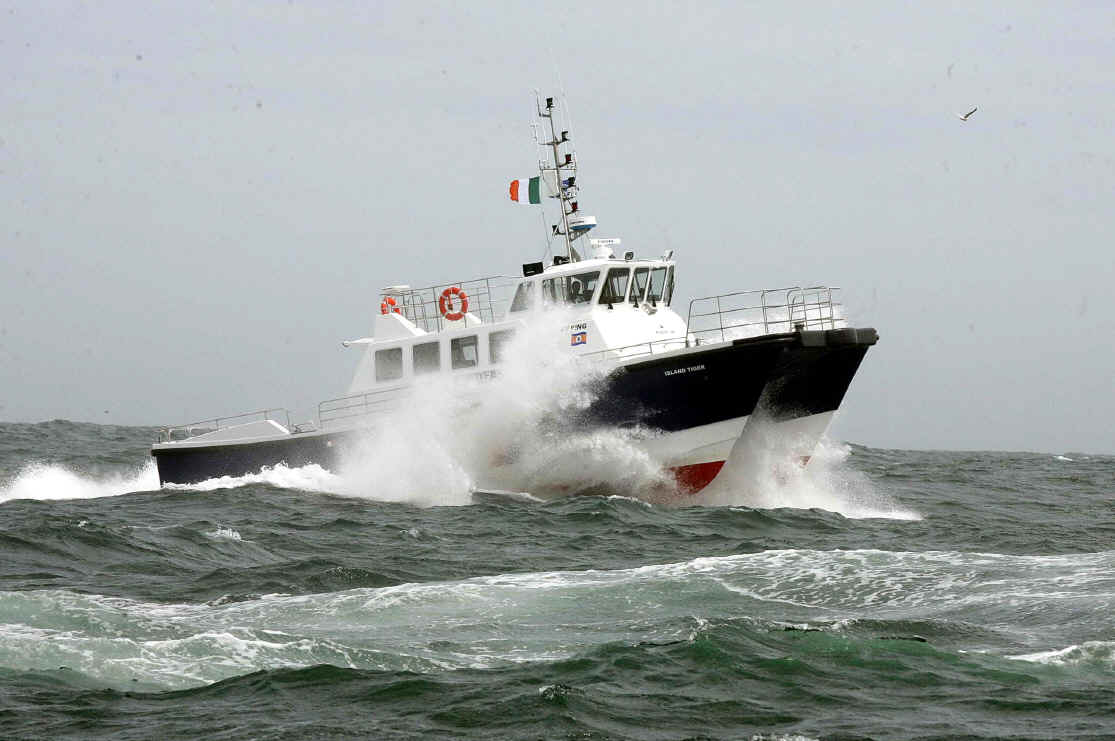
Above and below, photos taken from her rough weather sea trials, you can see a video of the trials from this link- SEE THE VIDEO
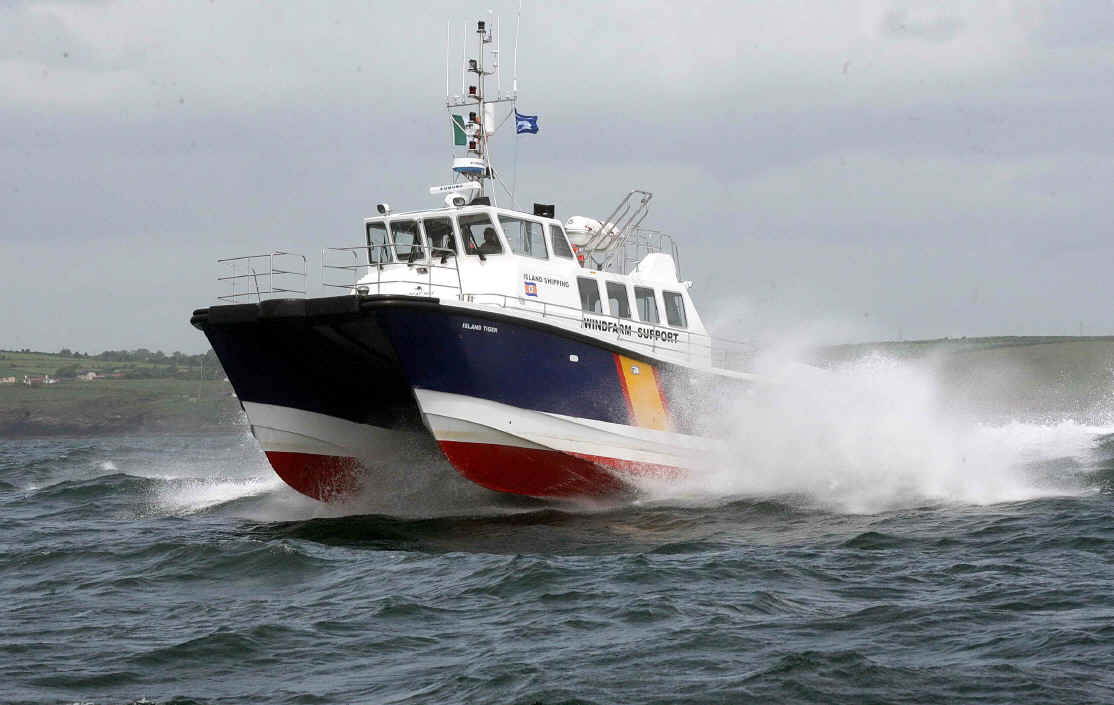
The Wildcat 53 hull design is a larger version of our very successful and thoroughly proven 36 / 40 design, featuring the same high buoyancy bow, symmetrical twin chine hull design that provides excellent sea keeping and performance, providing a soft ride into steep head seas with enough buoyancy in the f/wd sections to always lift the bow over waves, preventing slamming on the bridge deck. The hulls twin chine arrangement creates a spray air medium that allows the hull to almost ride on a cushion of air which gives the cat such a soft ride, and also makes for an exceptionally dry vessel. Down wind again the hulls provide adequate buoyancy to keep the bows up and the Wildcat hull is almost non broaching, allowing big quartering seas to be run down with little steering effort in total safety. Safehaven's hulls have gained an enviable reputation for strength and sea keeping over the years, their all weather pilot boats highly respected and it is this same design ethos that is bought into our new Wind farm Wildcat 53 / 16M.

ISLAND TIGER has very clean and graceful lines incorporating Safehaven's trademark 'gull wing' sheer line. Being of GRP construction means her finish is superb, with a high gloss, low maintenance finish and she has turned out a superb looking vessel.


OCEAN 3 provided the bow fendering. This is a heavy duty system comprising a polyethylene high density foam core with a 50mm thick rubber skin the will prove durable in service.
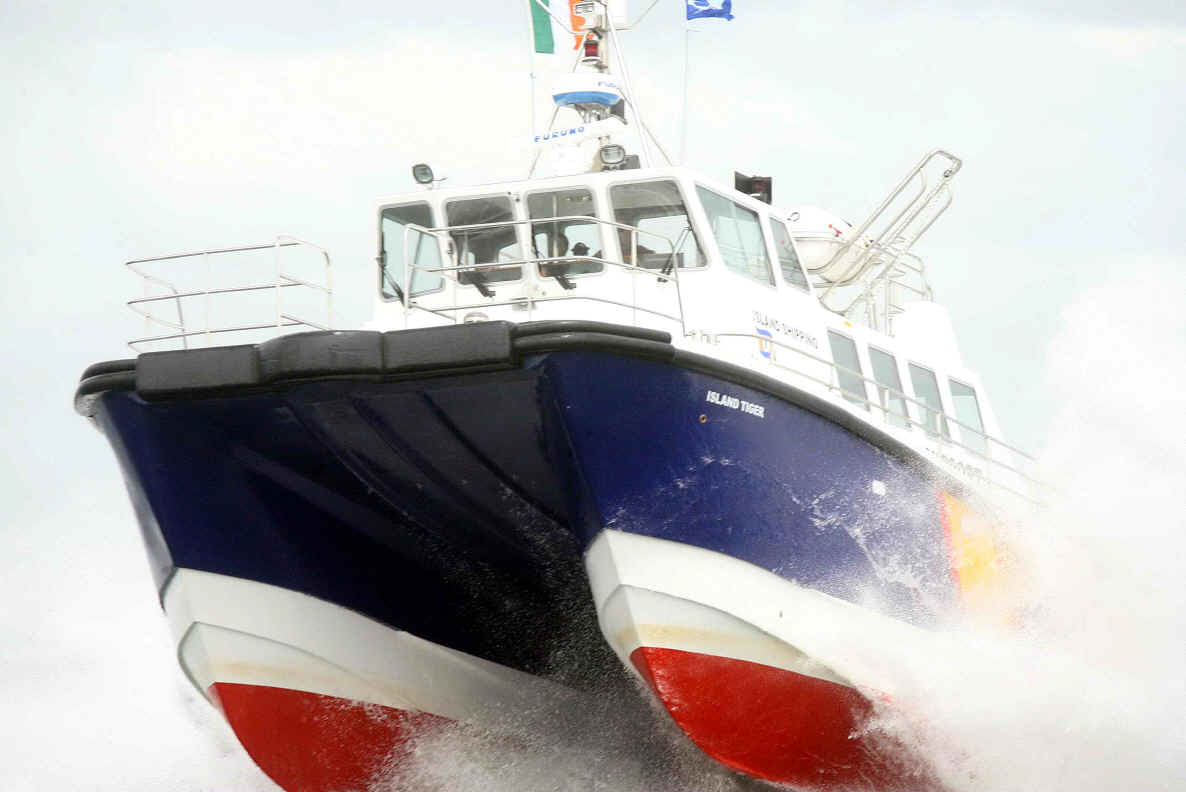
Both vessels will be powered by Ultra Dynamic 451 jet units powered by
Scania D12 engines. Water jets were chosen for their ability to provide high
thrust with lower mechanical stresses against the windfarm structure, combined
with good maneuverability, speed and safety. The vessel will be fully equipped
for windfarm operations, equipped with a HIAB crane with a 6m
reach, She will be equipped for dive operations with twin dive platforms
transom doors and is fitted with a 10kw generator providing 24v throughout the
vessel. To offer the most proficient level of
versatility to the offshore industry and is fitted out and equipped for survey
and hydrographic duties. She is built under dual certification for both
General
information
Light ship displacement
25,000kg
LOA 17m
Moulded
16m
Beam
6.1m
Draft-
Fully loaded - 1.0m
Fuel capacity
3600L
Water capacity
160 L
Engines
Scania D12 @ 650hp / 2200rpm
Maximum speed
25 kts
Operational speed 23kts
'IZURDIA' operating successfully in her home Port of Bayonne, France.
Izurdia has been in service for the past two months. Her pilots and crew
are very happy with her, testimony to this is a complimentary e mail from the
Ports chief pilot Bertrand Moutard:
Hi Frank.
The boys went outside at
the beginning of the bad weather, with about 5 meters, and they have all been surprised
with her excellent sea keeping and specially how they could maintained a good
speed in this condition.
Below are some photos showing her in operation and her 'pilot boarding ladder' in good use.
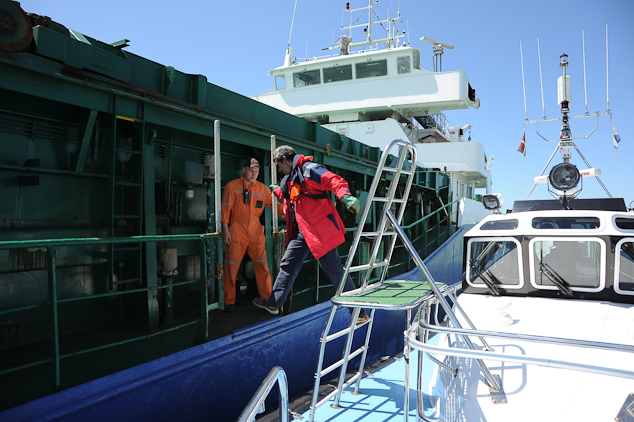
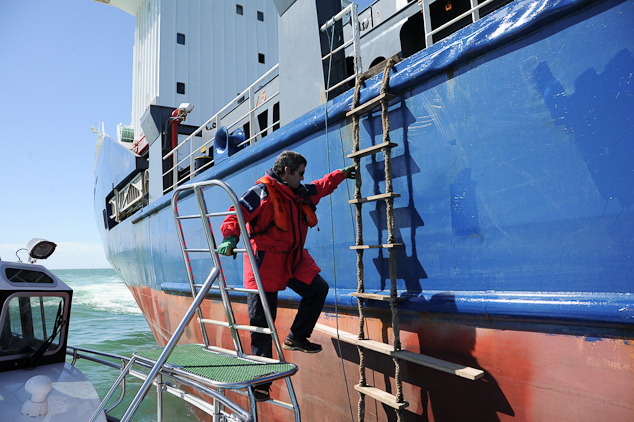
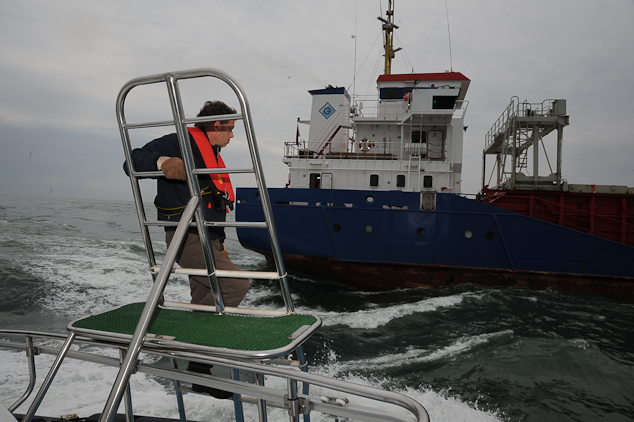
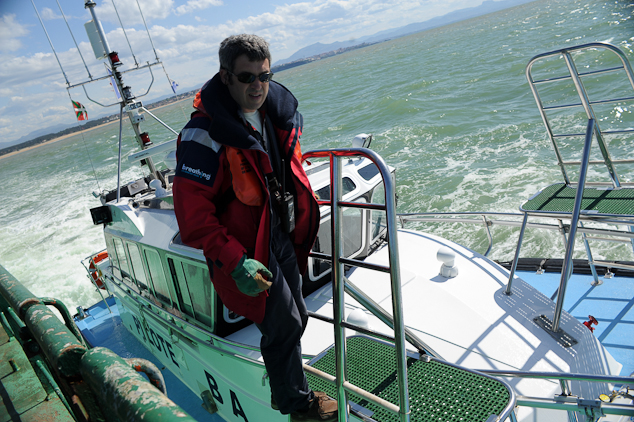
Interceptor 42 pilot for the Portuguese Port of Figueira Da Foz, 'CABO MONDEGO'

See a video of her being sea trialed offshore- SEE THE VIDEO
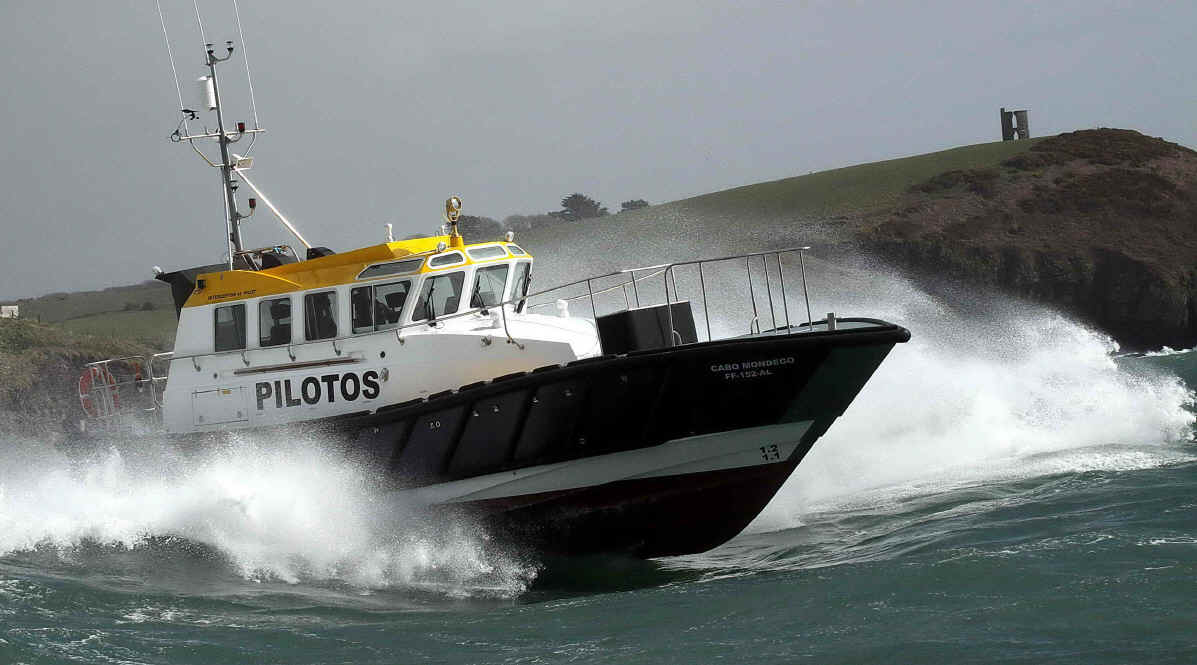
ATLANTIDA AZUL continues to operate successfully in the Portuguese Port of Sines, the Port authorities recently sent me some nice photographs of her offshore in gale force conditions, the Port and her crew report that they are very happy with her, especially her comfort and sea keeping.
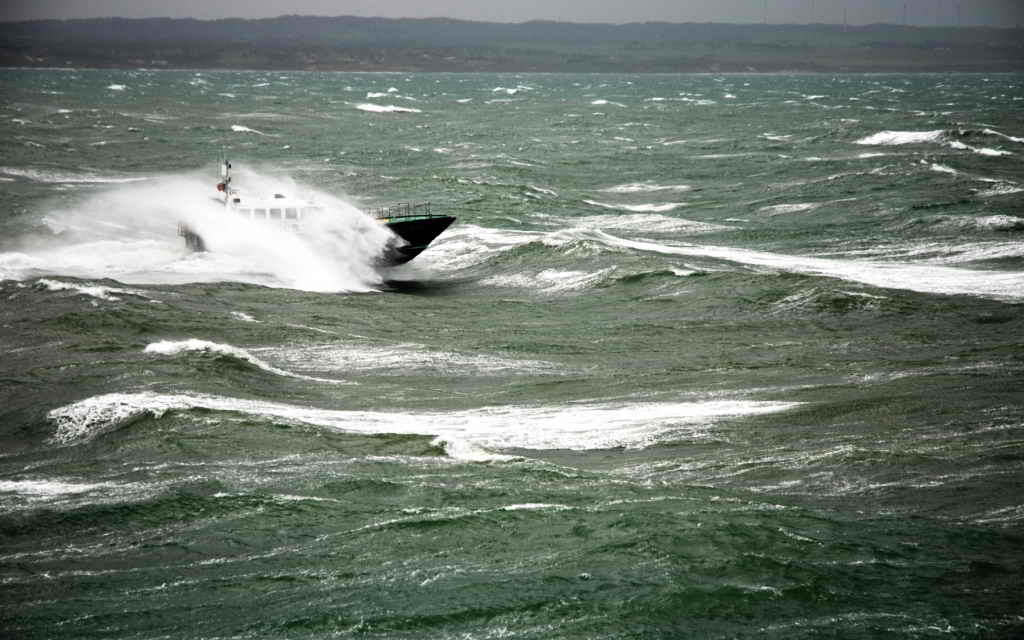
'PATHFINDER' Enters service alongside 'Spitfire' in the Port of Southampton.
Pathfinder is now in service alongside her sister ship Spitfire operating as pilot / patrol duties in Southampton's waters. Her crew are very happy with her and we have received a couple of nice e mails from her crew;
Hi Frank
I have used
Pathfinder now for 8 watches and she is a fantastic boat all round, the
changes you have made are spot on and she is a very well balance boat, a credit
to you and your team. I am gutted that I am on leave now for 2 weeks as I miss
driving the launch so much !!
Regards
Gary
Frank
Thought You'd appreciate some constructive Feedback on
Pathfinder!
We are all very appreciative of the fact that you listened to
how we would like the Pathfiders helm position/instruments/switches and to my
mind it really is spot on. Thanks. An inch plinth under the
throttle control would prevent the helm operator having to lean forward to
adjust controls but it is a minor niggle.
The improved Galley area is a big improvement on Spitfire too, as
is the improved internal lighting.
So Pathfinder is a great boat that I actually enjoy
maneuvering/operating. Well done!
Regards
John Hyland
Ps.. yeah and thanks for puttin' that music system in! It
really does make a big difference.
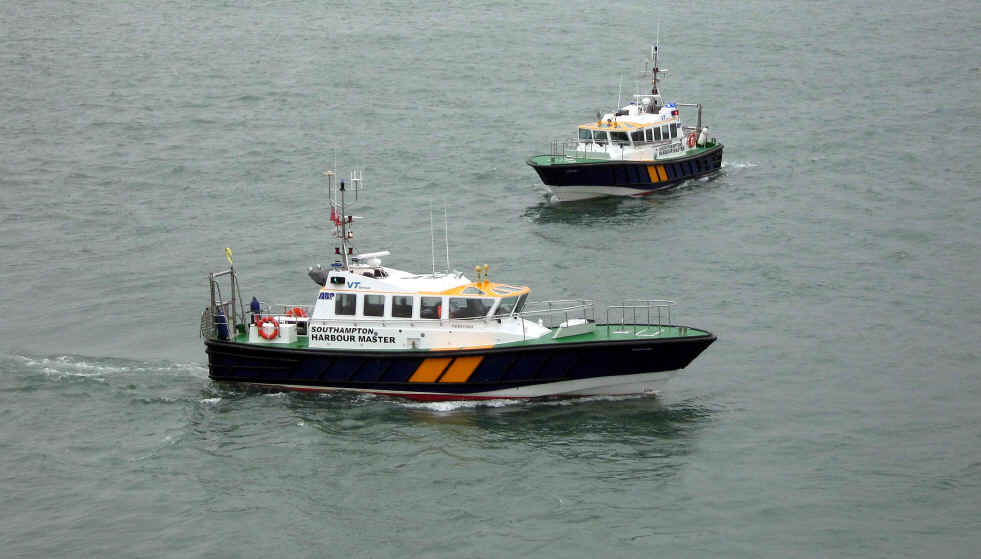
Anyone who missed the last newsletter might enjoy this video of her in Storm force 10 and 8m seas- See pics and video, click here
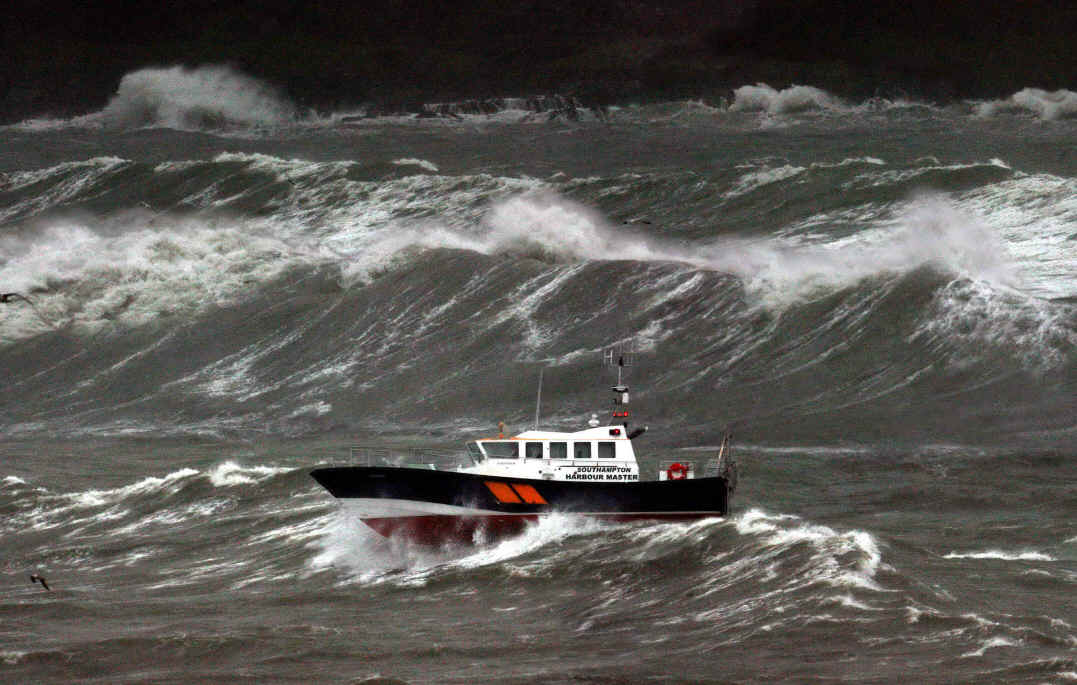
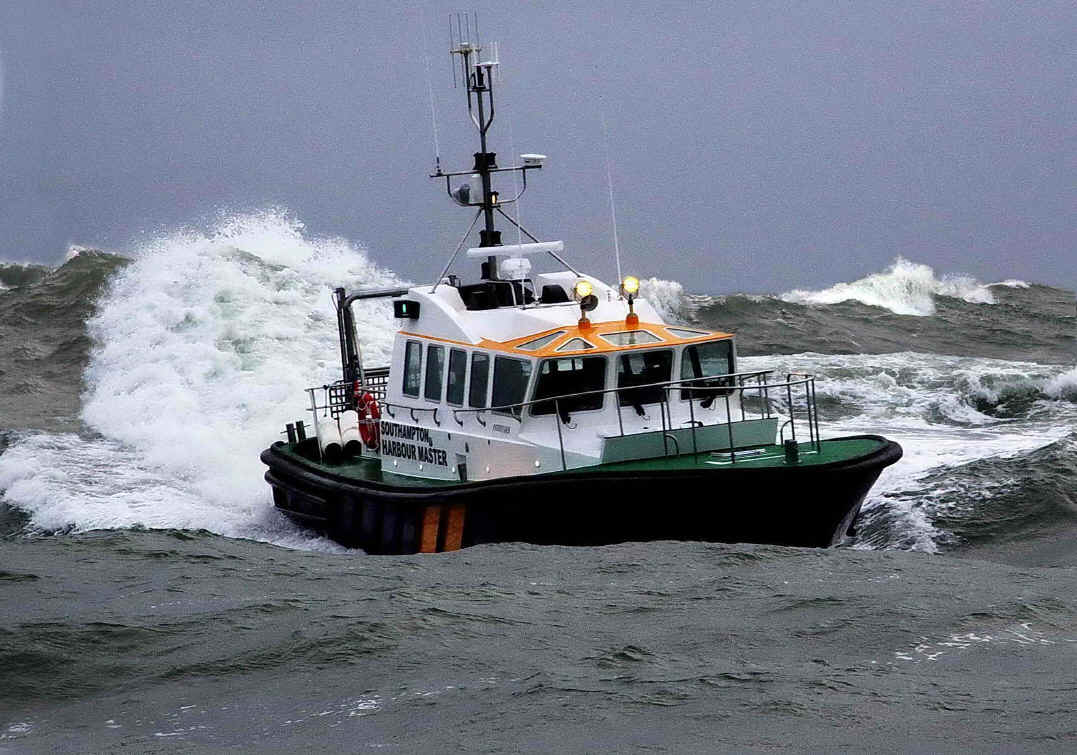
WILDCAT 40 'SEAFLOWER'
'SEAFLOWER' Kenny Livingstone's new Wildcat 40 has been launched. Kenny will be operating her commercially off the West Coast of Scotland.
Below are some nice photos the Wildcat 40 'SEAFLOWER' being sea trialed in a force 7 southerly gale in 3.5m seas. You can see a video of the trails on you tube, CLICK HERE TO SEE THE VIDEO
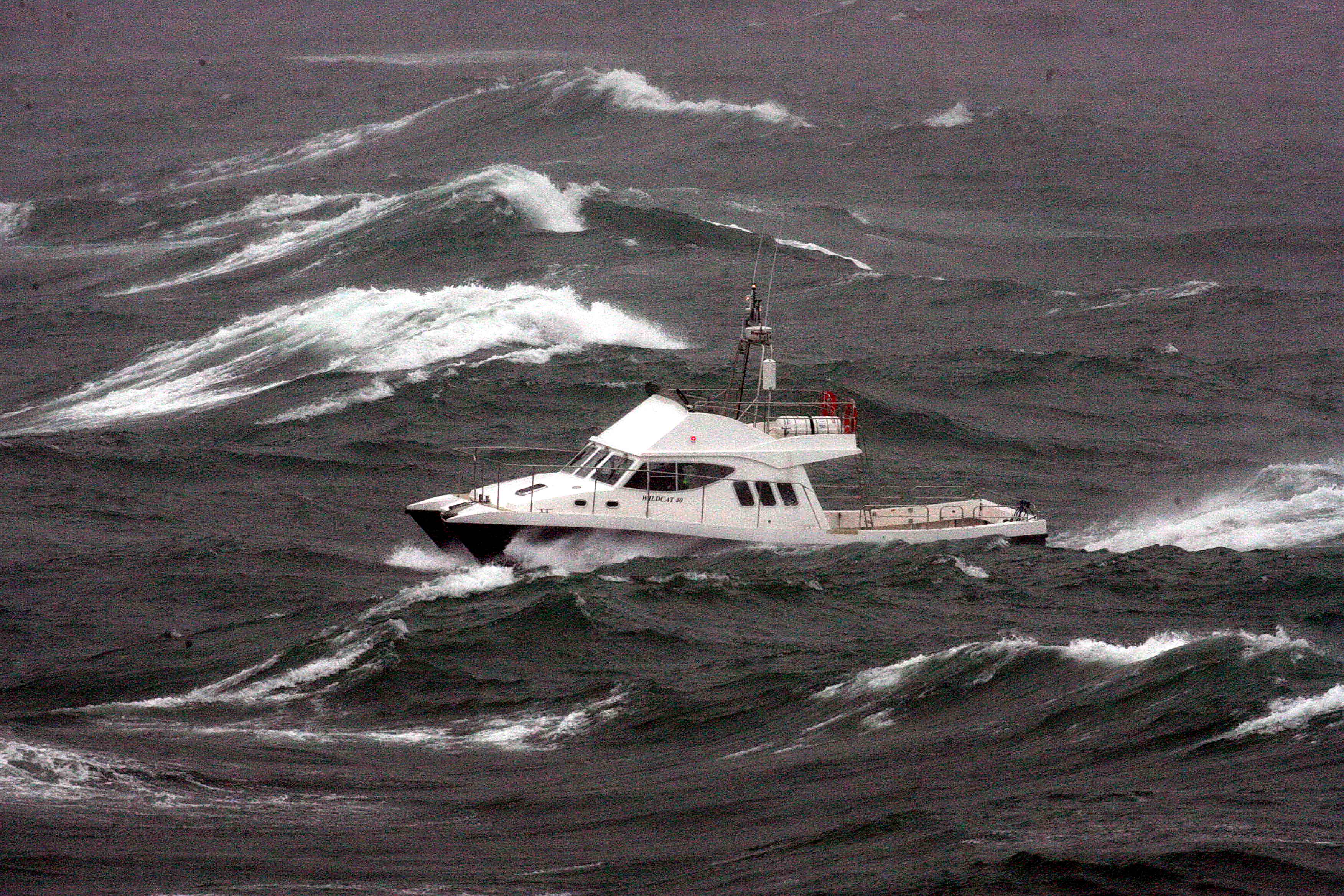
Running beam on in a Wildcat is no problem.
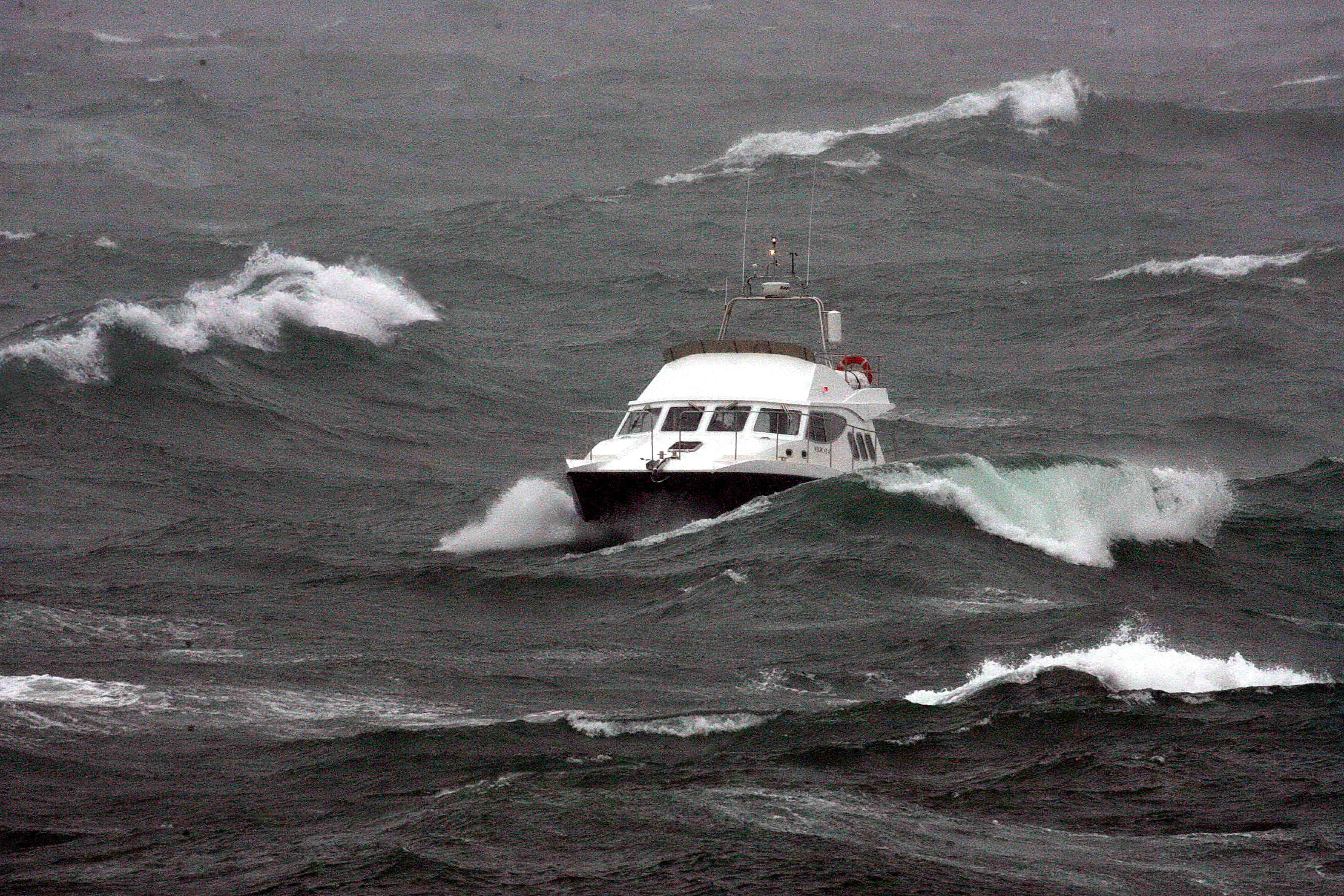
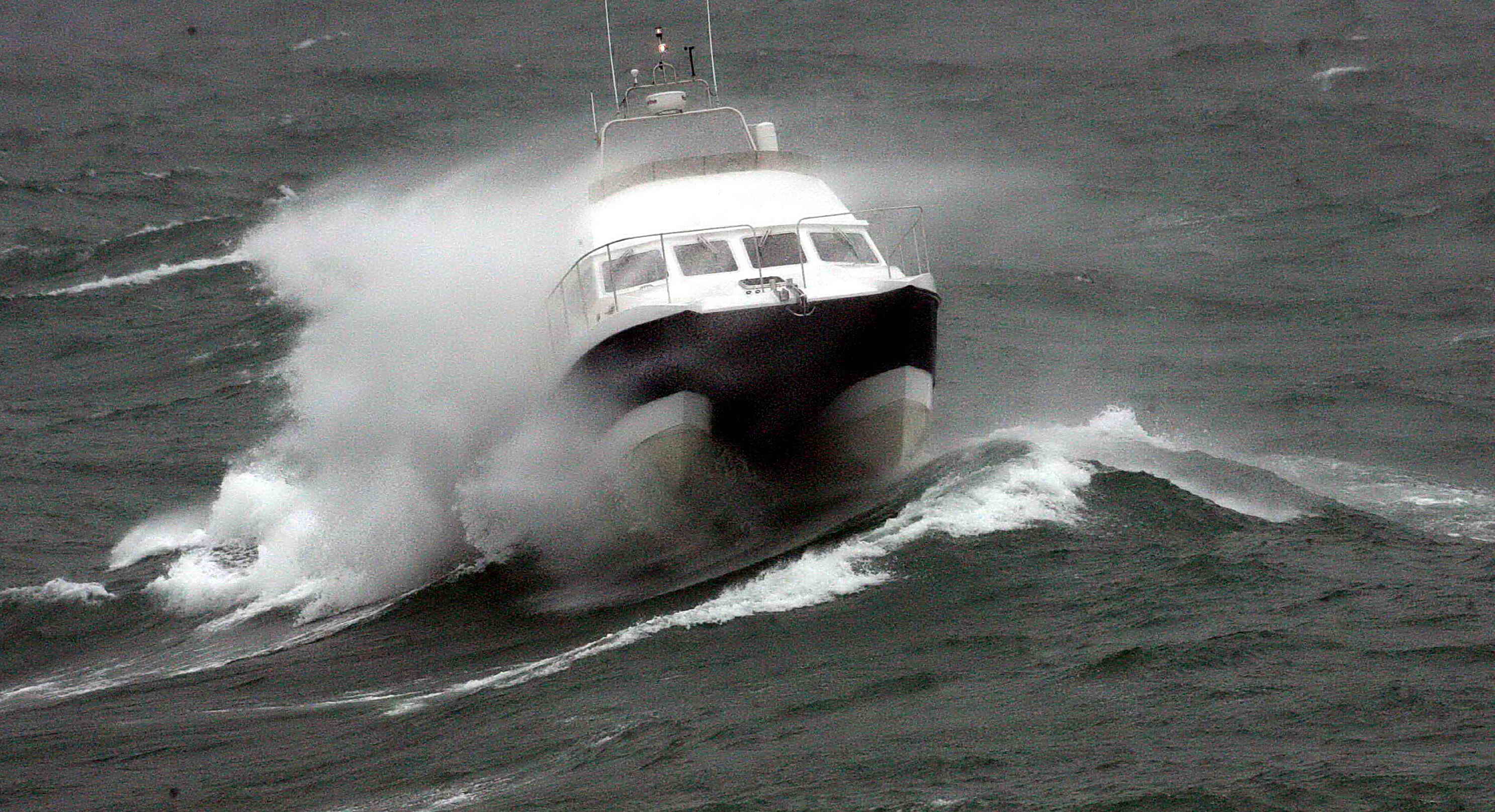
A few nice waves around on this day.
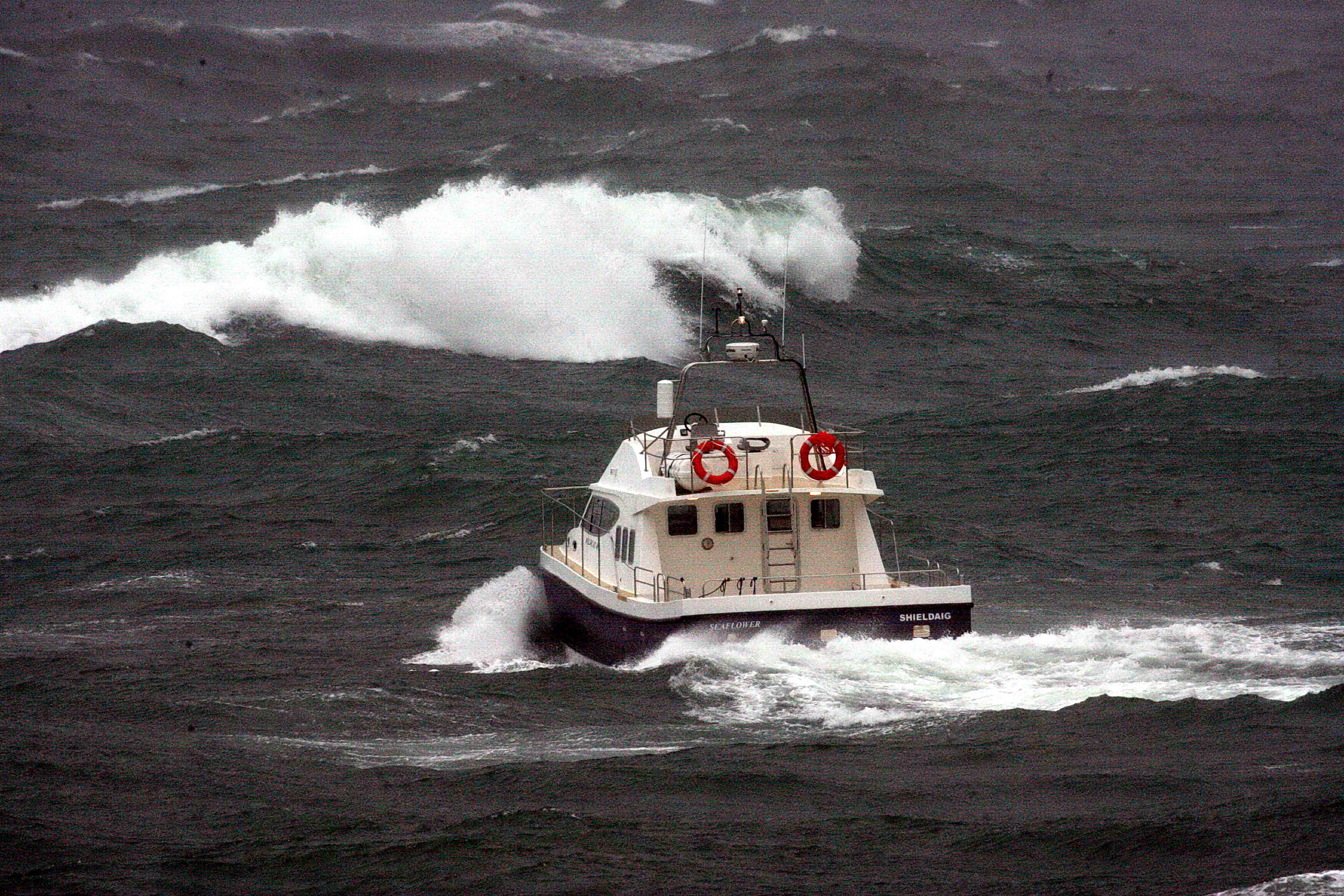

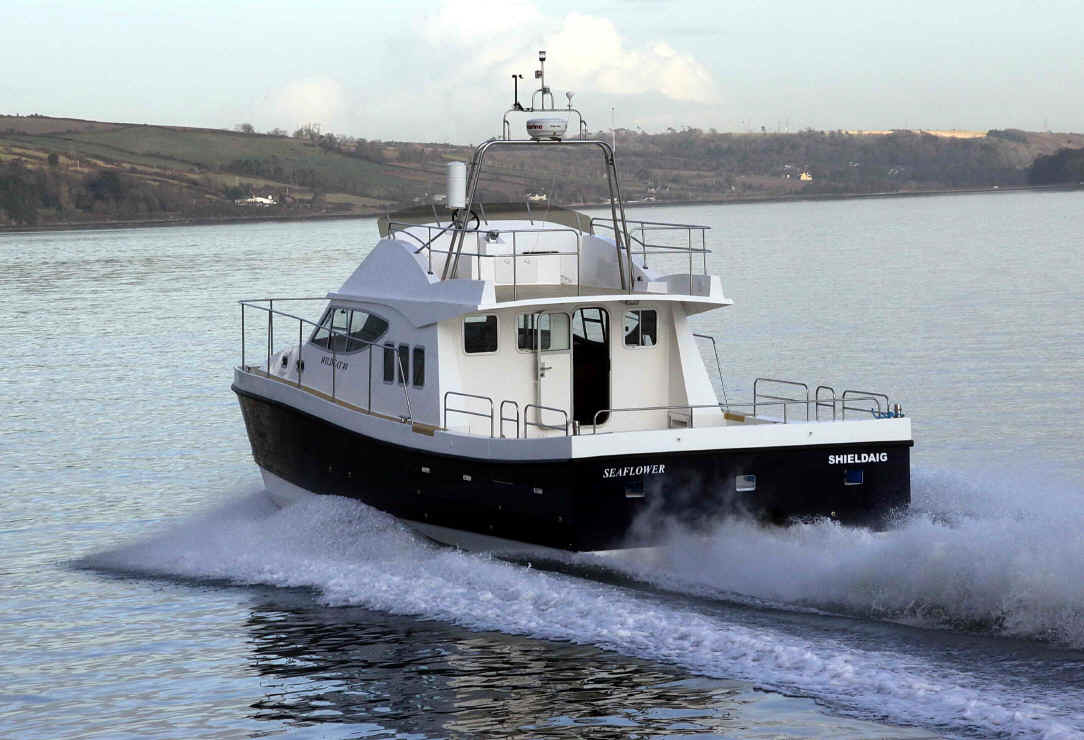 Below, the completed hull for the first of Island
Shipping's wind farm catamarans 'ISLAND TIGER'
Below, the completed hull for the first of Island
Shipping's wind farm catamarans 'ISLAND TIGER'
La Reunions Wildcat 40 Hydrographic survey vessel.
The Port of La Reunion have placed an order for our Wildcat 40 survey catamaran. The vessel will feature a moon pool deploying Cadden multi beam sonar equipment, it will be built under Bureau Veritas survey to French Maritime authority rules for commercial vessels and be powered by two Volvo D7 260hp engines. Below the chosen design below.
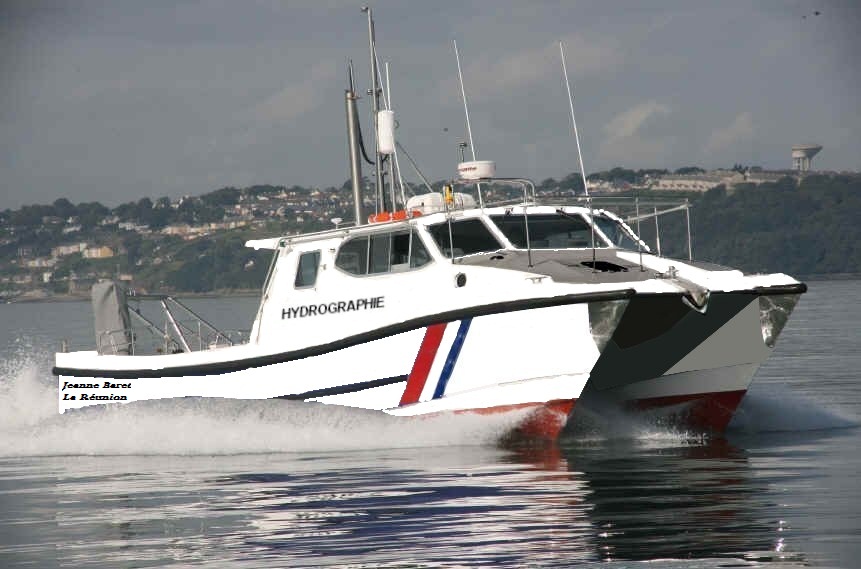
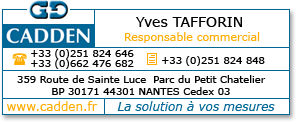
Below, her hull being laid up.
